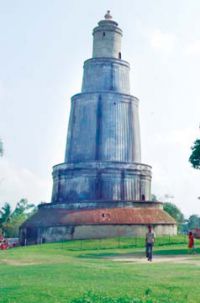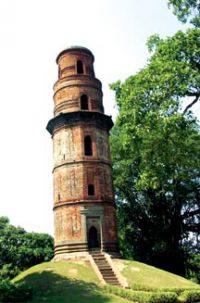Minar
Minar Indianised form of the Arabic or Persian word manar or manara, which literally means a place where fire (nar) burns. Originally it appears to have been applied to the Pharos (lighthouse) at Alexandria at the top of which a fire burnt at night as warning for mariners. It was also used in Arabic poetry for signposts or for the oil lamp in the cell of a Christian monk. Gradually, the meaning of the word was extended to building art to denote lighthouses, and during the time of the Muslims to include not only mosque-towers (madhana, from adhan) but also by analogy to embrace any structure whose height is its important dimension, whether isolated or forming part of a building as a functional or decorative item. The word thus eventually became a synonym for tower or turret in English.

The earliest minars in Syria and North Africa constructed during Muslim times were square in design, and were used also as living houses (sawami, pl. of sawmaa) beside being used as madhana. From eighth century onwards in Iran - the land of non-Arabs - the rounded form in contradistinction to the square was preferred. This, in association with the Ghazavid and Ghorid conquests came to India, where the earliest surviving examples are the minar at Sohdra in Panjab and the great Qutb Minar at Delhi. The size and height of these minars (the height of the Qutb Minar being more than 75m) bring forward an important question as to the necessity of their height and grandeur. From the inscriptions on their body, nothing precise is known about the purpose except the eulogy of the sultan and the glorification of Islam.

The fact that for a muadhdhan it is almost impossible to climb such a height several times a day for calling the faithful to prayer and that some of these minars, for example, those of Gazni, Jam and other places in Iran and India, are unconnected with mosques, indicates that these were erected to show the might (quwwat) of the ruler and of Islam, as a symbol of the victory and glory of the religion and the Islamization of the land where it was erected. It is interesting that this symbolization has been carried to modern times and the glory of a nation is represented by such towers as is seen in many countries, including the Nelson Tower in London, Eifel Tower in Paris, the Canadian National Tower in Toronto, and the Jatiya Smrti Shaudha (National Monument for Martyrs of Bangladesh) at Savar in Dhaka.
Of the few minars known to have been erected in Bengal, only three survive today, and all in West Bengal, India. The minar at Chhota Pandua and the firuz minar at Gaur of the Sultanate period and the one at nimsarai minar of the Mughal period are very high towers; the first two seemingly being connected with mosques, but the last one erected at the junction of Kalindi and Mahananda rivers as a light house for boatmen. Of the two other minars, also in West Bengal, one surmised to have been erected at the back side of the Adina Masjid at Hazrat Pandua and the other non-extant at Devikot were madhanas. It should perhaps be noted that madhanas in India in general and Bengal in particular were not that popular in early Islam.

The reason may be sought in the description left behind by Ibn Hawqal, a tenth century Arab geographer, who ascribes it to the 'stern orthodoxy of some rulers'. Because this feature of the mosque was not to be found in the mosque of the Prophet (Sm) at Madina, and was introduced only after the end of the pious Khilafat, they rejected it as superfluous. That this reason prompted most of the Indian rulers to exclude the madhanas from their mosques may further be supported by some of their mosque inscriptions. Whereas Abu Bakr (Ra), Umar (Ra), Uthman (Ra) and Ali (Ra) have been regarded in all these inscriptions as the chirag (lamp), the masjid (mosque), the mihrab (prayer-niche), and the mimbar (pulpit) of the Islamic religion respectively, no mention has been made of the minar. The call to prayer in Indian mosques, including those of Bengal, which did not have madhanas, was thus made either, as in the mosque of the Prophet (Sm) at Madina, from roofs, or from their gateways. In mosques that did not have staircases, the call to prayer must have been made, as is done nowadays, from the forecourt of the mosques, or some nearby high place. In modern times the situation is changing, and madhanas of varied types, sometimes even of grotesque designs, are being erected as necessary adjuncts to mosques.
In Bangladesh, from February 1952, minar has assumed a special meaning. To commemorate the martyrdom of the Language Movement, a minar known as shaheed minar (monument of the mother language martyrs) was erected by students near the gate of the Dhaka Medical College. Being symbolic of the repression inflicted by the Pakistani rulers, this has now assumed an abstract and symbolic form both in design and thought, and has been a feature imitated throughout the country, particularly in academic institutions. The grand Shahid Minar to the north of the Medical College, representing the country and its people, made by the famous artist-painter Hamidur Rahman, is now a large plaza, and is visited every year by people from all walks of life to commemorate the day (21 February) and to make fresh vows to resist oppression and reaction, and uphold the spirit of the Liberation War and independence. On other occasions, it is a monument dedicated to 'liberty, equality and fraternity'. [ABM Husain]
